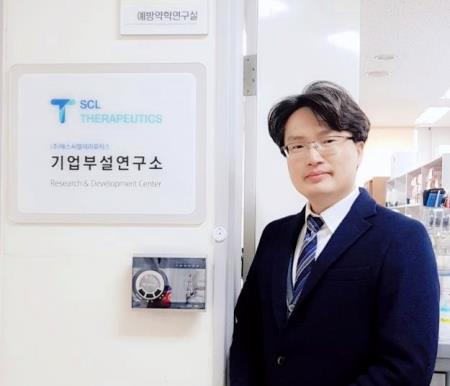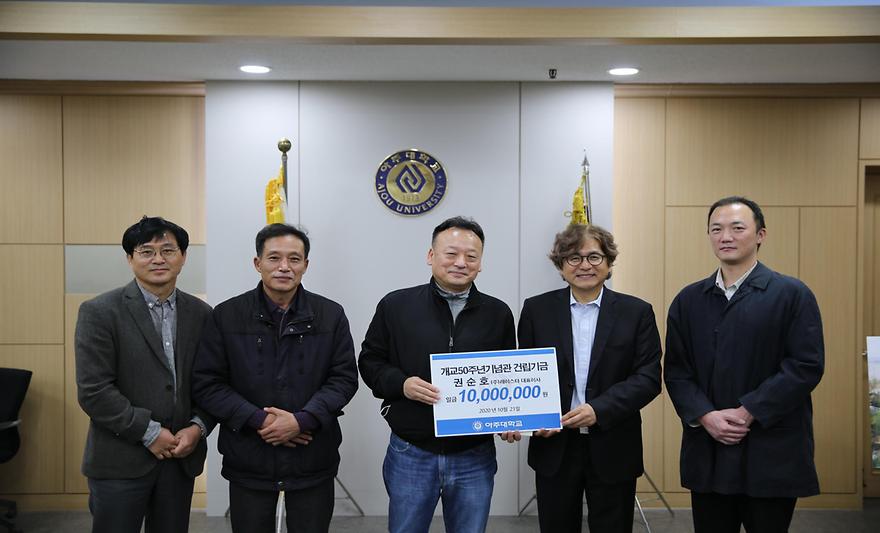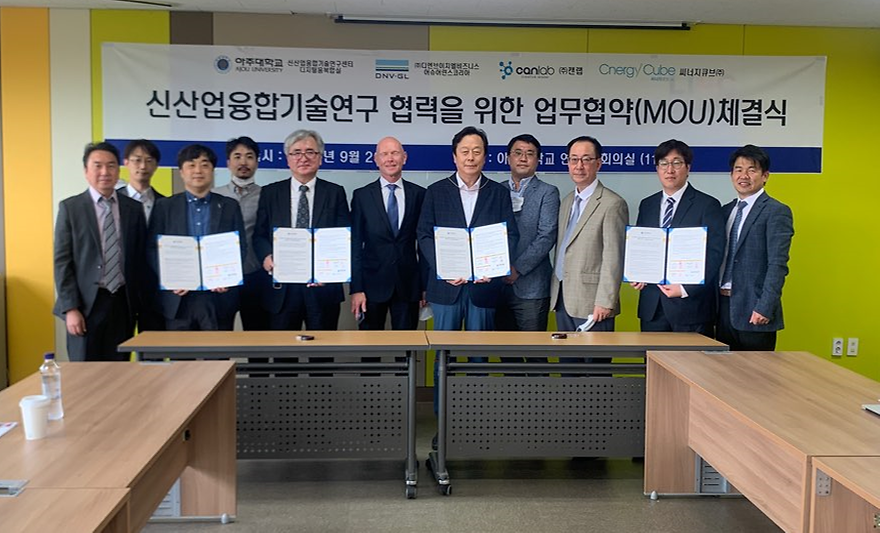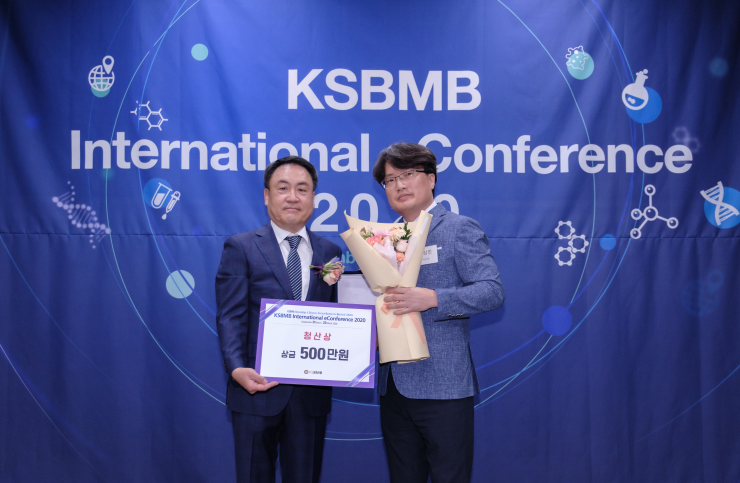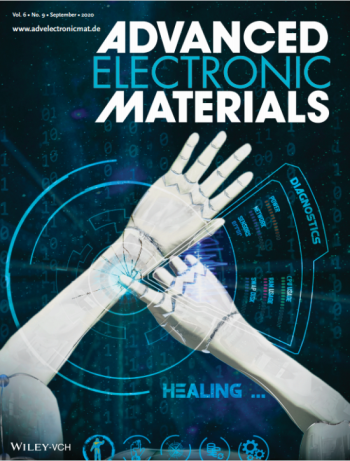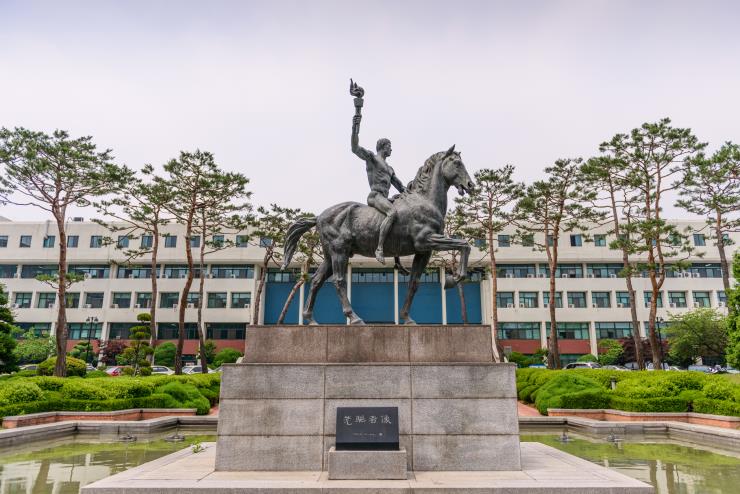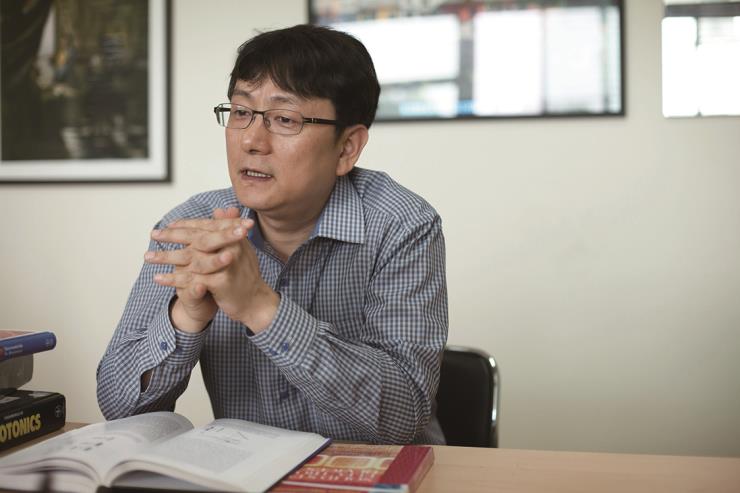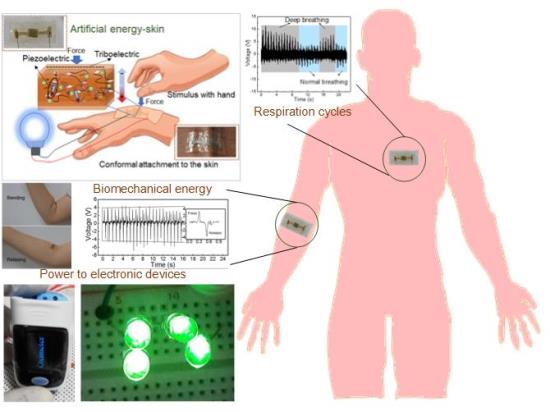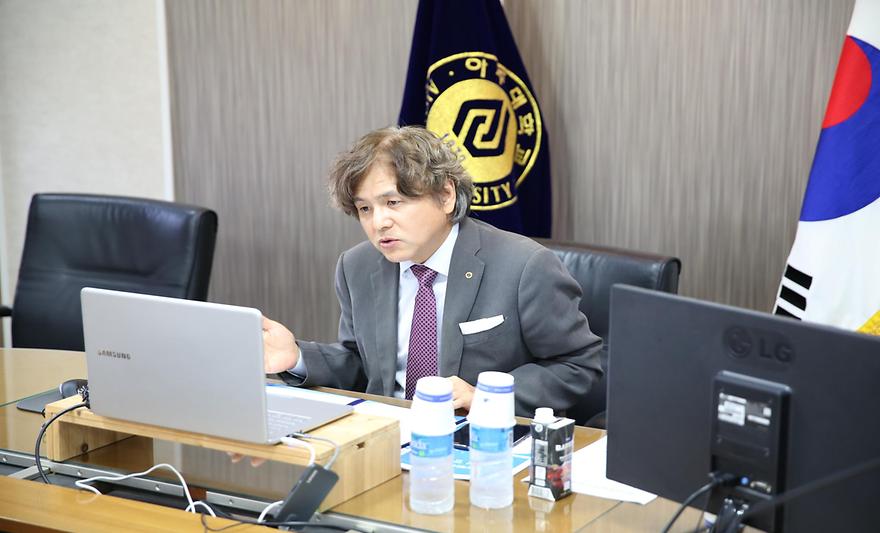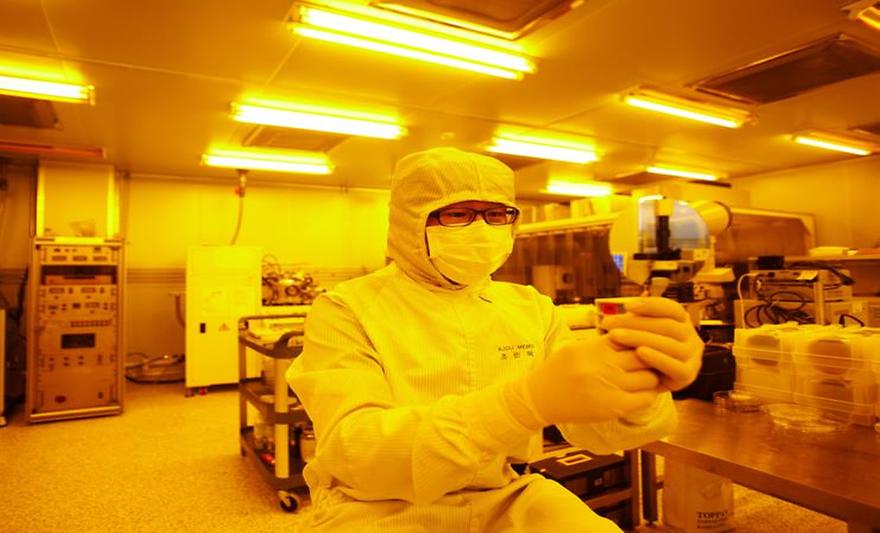-
A team led by Ajou University Professor Jeon Sang-min has found that a specific gene formerly considered helpful in prevention and treatment of cancer, in fact, stimulates its development and progression. Professor Jeon Sang-min (College of Pharmacy, photo) discovered that, contrary to traditional understanding, Nuclear factor E2-related factor 2 (NRF2) is a gene that stimulates cancer development and is also related to poor clinical outcomes, not at all a tumor suppressor gene. His study was published in Clinical Cancer Research on October 19th and entitled, “NRF2 activation promotes aggressive lung cancer and associates with poor clinical outcomes”. Professor Jeon Sang-min, PhD student Choi Eun-ji, US company Genentech, and a research team from Johns Hopkins Medical Institutions participated in the recent study, which was sponsored with a grant from the Korea National R&D Program for Cancer Control (Ministry of Health and Welfare) and the Basic Science Research Program (Individual Basic Science & Engineering Research Program) under the Ministry of Science, ICT and Future Planning.NRF2 has long been considered helpful in preventing and treating cancer as it was believed to reduce reactive oxygen species (ROS) once it is processed into a transcription factor that activates anti-oxidation pathways. However, several recent findings have suggested that NRF2 may actually contribute to tumor development, because in many cases of cancer, including cancer of the lung, NRF2 was activated.Another study also found that, in lung cancer cases, NRF2 activation occurred along with the mutation of STK11/LKB1, which are other tumor suppressor genes. Accordingly, the joint research team conducted experiments based on a genetically modified lung cancer mouse model (Kras/Keap1/Stk11-KO) and analyzed the results of the latest large-scale lung cancer clinical trials (OAK, IMpower131). The research team identified that, in the genetically modified mouse model, the activation of NRF2 stimulated lung cancer development and lowered survival rates. The team also found that the STK11 gene mutation increased ROS and stimulated the progression of lung cancer development. When STK11 mutation and NRF1 activation were both taking place, they suppressed ROS, further promoted lung cancer development and significantly lowered survival rates. The research team discovered that the reason NRF2 activation and STK11 mutation happen simultaneously in lung cancer cases is because NRF2 activation reduces oxidative stress incurred by STK11 mutation leading to cancer cell survival and growth. In conclusion, the study produced meaningful findings proving that NRF2 is a tumor oncogene, not a tumor suppressor gene. The team also analyzed recent clinical trials and found that lung cancer patients with active NRFs were highly likely to have poorer chemotherapy and immunotherapy outcomes than those who didn’t have active NRFs, and had significantly lower survival rates.Professor Jeon Sang-min stated “The study suggests a paradigm shift in the role of NRF2 in cancer. […] Many attempts have been made to develop an NRF2 stimulant for cancer prevention and treatment. However, our research has set the record straight and contributed to increasing interest on the development of an NRF2 inhibitor.”Professor Jeon’s research team is continuing efforts to be the first in developing such an NRF2 inhibitor drug. Professor Jeon participated in joint creation of SCL Therapeutics, a bio start-up, for clinical development of the self-discovered NRF2 inhibitor candidate. Currently, the lab is conducting pre-clinical trials.
-
466
- 작성자OI***
- 작성일2020-11-19
- 6817
- 동영상동영상
-
<Photo: From left: EP Global CEO Kang Won-gu, Paint Wall Mart CEO Kwon Hoe-jung, RAY Star CEO Kwon Soon-ho, Ajou University president Park Hyung-ju and dean of the Chemical Engineering Department, Kim Ju-hyung> The Chemical Engineering 1985 Alumni Association continues giving to the university. Its donation relay campaign began in 2016 and has continued every year. This year, Kwon Soon-ho, member of the Chemical Engineering 1985 Alumni Association, continued the relay with a monetary gift to the university. RAY Star CEO, Kwon Soon-ho started his undergraduate studies in the Ajou University Department of Chemical Engineering in 1985. He donated 10 million won towards establishment of a commemorative hall celebrating Ajou’s 50th anniversary, becoming the fifth “runner” in the relay donation campaign.The donation hand-over ceremony was held at the president’s office on October 21st. Park Hyung-ju, President of Ajou University, extended his gratitude on behalf of the Ajou family and held a luncheon. The previous donors to the relay donation campaign also participated.The campaign was introduced by the alumni association of the Chemical Engineering department and began with EP Global CEO Kang Won-gu in 2016. This year celebrates the fifth year of continued donations: Innofiltech CEO Kim Jung-woo in 2017, EKC CEO Kang Min-gu in 2018, and Paint Wall Mart CEO Kwon Hoe-jung in 2019 all contributed 10 million won. The alumni are now one step closer to their goal of donating 100 million won within a decade thanks to the recent donation made by Kwon Soon-ho. Kang Won-gu directed his donation to the Ajou University Central Library, Kim Jung-woo contributed to further development of the Electrical and Computer Engineering Department, while gifts from Kang Min-gu and Kwon Hoe-jung went towards advancement of the Chemical Engineering Department.
-
464
- 작성자OI***
- 작성일2020-11-19
- 6728
- 동영상동영상
-
Ajou University’s Bio & Healthcare Industrial Cooperation Center (ICC), one of Ajou’s LINC project groups, completed installation of and held a tape cutting ceremony for ‘Health Donation Stairs’ at Gwanggyo Jungang (Ajou University) Station on the Sinbundang Line.The ceremony, held on September 28th at the Gwanggyo Jungang (Ajou University) Station of the Sinbundang Line, enjoyed the attendance of many distinguished guests such as Oh Young-tae, vice president for Industry-Academia Cooperation, Kim Su-dong, head director of Bio & Healthcare ICC and other faculty, and the CEOs of ICC partners: Cell & Bio CEO Lee Yong-woon and Yeskin CEO Ryu Hyungjun. Oh Byung-sam, CEO of Neo Trans, the company running the Sinbundang Line, also joined.The Health Donation Stairs project was first introduced as a social contribution effort and realized through the sponsorship of companies and public participation. Financial contributions were made by participating companies and funds could be donated by people walking up the stairs from the subway. All funds collected through the Health Donation Stairs are given back to society.Many partner companies to the Bio & Healthcare ICC and the LINC+ project group engaged in the process and contributed funds needed to install the Gwanggyo Jungang (Ajou University) Station’s Health Donation Stairs. The goal of this project is to promote local health by attracting people to walk up the stairs (instead of taking the escalator), promote the Bio & Healthcare ICC partner companies, and using donations to purchase winter kits for members of marginalized groups. A tripartite MOU was signed between the Bio & Healthcare ICC, one of Ajou University’s LINC+ project groups, Neo Trans and the Community Chest of Korea to kick things off. The actual stairs were first installed in August this year at Exit No.1 at Pangyo Station; the project was further expanded to install another Health Donation Stairs at Gwanggyo Jungang (Ajou University) Station in September.Oh Young-tae, Vice President for Industry-Academia Cooperation stated, “The campaign is all the more meaningful as it goes beyond simple industry-academia cooperation,” adding, “It is a best practice possible through strong cooperation between the university and its ICC partners with the aim carrying out the social responsibilities of the university and companies and giving back to local communities.” Oh Byung-sam, CEO of Neo Trans, which operates the Sinbundang Line, explained, “Donations will be used to help the underprivileged in our community.”The ICCs are clusters, created by Ajou University, to foster collaboration with local businesses and industries and nurture talented people. There are four areas of specialization: bio-healthcare, smart mobility, new and renewable energy, and AI and big data. These areas were selected through analytics on Ajou’s core competence and local industry in accordance with the Ajou Industry-Academia Cooperation Development Plan. The LINC+ project group is actively implementing various industry-academia cooperation projects such as joint technology development, technology transfer and commercialization, on-the-job trainings Capstone Design programs and consultative body activities. It is currently engaged in creating “Ajou Valley,” an innovative industry-academia ecosystem.
-
462
- 작성자OI***
- 작성일2020-11-19
- 6679
- 동영상동영상
-
Ajou University’s New Industry Convergence Technology R&D Center concluded a Memorandum of Understanding (MOU) with parties including DNV GL Korea to establish close cooperation in the field of convergence technology.The New Industry Convergence Technology R&D Center (Lee Joo-yeon, Director) and the Digital Convergence Division (Kim Young-min, Chief) announced conclusion of an MOU with DNV GL Korea (Lee Jang-seop, CEO), CANLAB (Kim Dong-hyun, CEO) and Cynergy Cube (Park Eun-seok, CEO) towards establishing close cooperation using in-depth knowledge and technology in the field of new industry and convergence technology essential for Industry 4.0. Ajou University Graduate School of Science and Technology Policy (Lee Joo-yeon, Chief) will also participate in collaboration.DNV GL, the company that signed the MOU with the New Industry Convergence Technology R&D Center, is a major Norwegian company specializing in development of new business models, R&D, safety and credibility assessments, evaluation and certification and demand-based customized training services in the field of traditional infrastructure industries such as aviation, shipping, and railways, as well as Industry 4.0. sectors like AI, autonomous driving, and smart factories. CANLAB develops AI-based autonomous driving video systems, while Cynergy Cube is a consulting firm for system and software companies. The signing ceremony was held on the 23rd at Yeonam Hall. Head director of the New Industry Convergence Technology R&D Center, Lee Joo-yeon, division chief of the Digital Convergence Division, Kim Young-min, and professor Jung Myung-seok participated. In addition, dean of the Systems Engineering Department, Park Peom, Norwegian Ambassador to the Republic of Korea, His Excellency Frode Solberg and executives from partner companies also joined the ceremony. The parties to the MOU agreed to cooperate on planning and executing joint projects, exchanging talent and technology, and forming and operating a working group in some major areas such as the smart grid, smart factories, smart fintech, autonomous driving, blockchain, and system and industrial safety. Professor Lee Joo-yeon said, “We will continue our cooperation to develop new growth engines, promote joint R&D projects, and further advance system engineering capabilities essential to the development of Industry 4.0., more specifically by forming an organic cooperation system based on the MOU.” At the signing ceremony, H.E. Ambassador Frode Solberg stated “The embassy will be a hub to boost synergy through cooperation between Norwegian universities and companies, Ajou University’s New Industry Convergence Technology R&D Center and the Graduate School of Science and Technology Policy.”
-
460
- 작성자OI***
- 작성일2020-11-19
- 5765
- 동영상동영상
-
The students of Eureka, an extracurricular club of Ajou University, received many awards at the “Best of Best Invention” of the 5th Korean International Youth Olympiad (KIYO). Eureka is an invention club made up of students who are interested in inventing, manufacturing, and patents.The Best of Best Invention features upgraded versions of inventions that have already received awards in international competitions or inventions that are based on original ideas. To participate, one must have previously received one or more awards from an invention competition either in Korea or overseas.This year’s KIYO was participated in by elementary, middle, and high-school students from 18 countries and 500 university students. It was held remotely to help prevent the spread of COVID-19. Applications and inventions were submitted in September, with the screening results announced on October 12.Ajou University’s team received seven awards: three gold, two silver, and two special awards. The three gold award-winning inventions were: 1) a braking device for a stroller that takes into consideration differences in height between the front and rear wheels, 2) a syphon device that can control the quantity of liquid that passes through it based on a disk and coiled hose, and 3) a KMARK-1 (auto-injector) that can be stored safely (without risk of accident) through its protruding end and a groove and inject multiple agents sequentially.Park Jin-hyung, Eureka’s president, said, “Despite the fact that it was not easy to work together because of the continued threat of COVID-19, everyone worked very hard. Thanks to the support from Ajou University, we were fortunate enough to receive several awards. Our goal is to use our ideas to breath new energy and life into Korean society.”Eureka received the funding necessary to participate in KIYO through the LINC+ Center’s support program for outside startup contests. Starting this year, the center also provides funding to support undergraduates in preparing samples and for participation fees for outside startup contests. It also has a startup advisory group that is made up of experts from a wide range of areas who help students who wish to start their own business.
-
458
- 작성자OI***
- 작성일2020-11-04
- 4728
- 동영상동영상
-
-
456
- 작성자OI***
- 작성일2020-11-02
- 3937
- 동영상동영상
-
모션 센서 적용Motion detector applied샘플구조Sample structure저항변화Change in resistance치유Healing손상Damage자가치유Self-healing수소결합Hydrogen bondingA team of researchers led by Prof. Seo Hyung-tak (Departments of Materials Science and Engineering and Energy Systems Research) has successfully developed a new self-healing composite material and a sensor based on that material. Highly conductive and elastic, the new material is expected to have wide-ranging applications, including wearable electronics, soft robotics, and artificial skin.The composite invented by Prof. Seo’s team is made of a supramolecular polymer and copper microparticles, and the team developed an electronic wearable strain sensor capable of self-healing. The researchers’ work was published as the featured article in the September 7 online issue of Advanced Electronic Materials and entitled, “Intrinsically stretchable and self-healing electroconductive composite based on supramolecular organic polymer embedded with copper microparticles.” Rubaya Yeasmin, a doctoral candidate at Ajou, was listed as first author.The human skin is structured so that it detects damage quickly and activates self-restoring mechanisms to prevent the damage from worsening and facilitate healing. Inspired by this natural self-healing mechanism of organisms, researchers worldwide are searching for new materials capable of self-healing and restoration, and possessing electroconductivity and elasticity (stretchability). It takes significant skill and resources to develop new electronic materials capable of restoring themselves after damage without external intervention or processes. Once invented, such materials can exert far-reaching ripple effects on industry and society.In this project, the research team combined a supramolecular organic polymer and copper microparticles (1 μm = 1E-6m; for comparison, the average width of a hair strand is 100 μm). The resulting composite can be manufactured on a mass scale in aerosol and gel form. The copper concentration can also be adjusted to control electroconductivity of the final product. Supramolecular polymers support elastic and self-healing hydrogen bonding. The copper concentration can also be used to control the electric properties of semiconductors and conductors. The team has optimized the electrical properties of their composite so that it can continue to restore itself, notwithstanding multiple cuts. The most remarkable characteristic about the team’s product is its highly stretchable and self-healing structure, which renders it very similar to real skin. This material is resistant to tearing and can be stretched to 120 percent of its original length. Its electric and mechanical properties are also restored even after it has been cut. The team, in fact, demonstrated that the material recovered 90 percent of its mechanical properties and 100 percent of its electrical properties in just five minutes in the given environment.The team used the new material to develop a new wearable strain sensor capable of self-healing, whose workings it successfully demonstrated by attaching it to the fingers of human subjects. By deliberately cutting and damaging the sensor and gauging its reaction, the team also confirmed its ability to restore itself.Prof. Seo explained: “The self-healing material we’ve developed was made with affordable components and processes, without the need for great cost. A wide range of applications are possible beyond only wearable sensors, and include elastic IoT sensors, soft robotics, and industrial equipment.”The project was conducted in part thanks to the Research Support Program for New Researchers with Advanced Overseas Accomplishments, the Basic Research Support Program, and the BK21 Four Program from the Ministry of Science and ICT and the National Research Foundation of Korea.
-
454
- 작성자OI***
- 작성일2020-11-02
- 4132
- 동영상동영상
-
-
452
- 작성자OI***
- 작성일2020-11-02
- 4002
- 동영상동영상
-
A team of researchers led by Prof. Ahn Yeong-hwan (Departments of Physics and Energy Systems Research, pictured) has succeeded in creating a new quantum energy level using a material that is expected to become central to next-generation solar cells.The team’s work was published in the September issue of Nano Letters (IF = 12.344) with the title, “Phonon-Polaritons in Lead Halide Perovskite Film Hybridized with THz Metamaterials.” The team included other Ajou faculty members, including professors Ha Na-young, Park Ji-yong and Lee Soon-il, all with the Department of Physics, as well as Prof. Kim Dai-sik of the Ulsan National Institute of Science and Technology (UNIST). Kim Hwan-sik, doctoral candidate in physics at Ajou, also participated as first author.The team created a hybrid of the perovskite film and the metamaterial used to create invisibility cloaks and tested how light in the terahertz range, between infrared rays and microwaves, behaved on it. The perovskite used for this particular experiment was a lead halide type, widely expected to become the central material of much more efficient solar cells in the future.The perovskite hybrid, in its oscillating mode, reacted strongly with the electronic waves concentrated in the meta-structure, giving rise to a new phonon-polariton energy level. An energy level is the value of energy at its atomic and molecular levels. It refers to the level of energy that electrons absorb or release.The team also demonstrated that the new energy level varies depending on numerous conditions or variables. The most important of these variables is crystallinity of the perovskite film. The team discovered, for the first time in the world, that the dynamics of the phonon-polariton energy level vary by the nanocrystal growth dimensionality (one-, two-, or three-dimensional). The team also succeeded in introducing a new model for explaining the interaction between nanocrystals that grow over time and light. Prof. Ahn explained: “Our latest discovery can be applied to assessment of the crystal structure of next-generation solar cell films as well as optimization of their efficiency. Through follow-up research on the perovskite-metamaterial hybrid, we were also able to find lighting sources for future quantum optics.”The project was made possible in part thanks to the Mid-career Researcher Program, co-managed by the Ministry of Science and ICT and the National Research Foundation of Korea, and Korea Energy Technology Evaluation and Planning (KETEP)’s Energy Workforce Development Program.THz 파THz raysMAPbl3 페로브스카이트MAPbl3 perovskite메타물질Metamaterial강한 상호작용Strong reaction페로브스카이트PerovskiteMechanism of the new energy level based on the perovskite film-metamaterial hybrid
-
450
- 작성자OI***
- 작성일2020-11-02
- 4046
- 동영상동영상
-
Using an engineered silk protein, a team of researchers led by Prof. Kim Sung-hwan (Departments of Physics and Energy Systems Research) has succeeded in developing artificial tissues capable of generating energy. The invention is expected to accelerate the development of next-generation healthcare devices that can be incorporated into existing human tissues.Prof. Kim’s human-friendly artificial skin, made of an engineered silk protein and capable of harvesting electric energy from human motions, was published in the August 23 online issue of Nano Energy, a renowned international publication, and entitled, “Self-powered artificial skin made of engineered silk protein hydrogel.”There is a fast-growing body of research worldwide on materials for next-generation electronic healthcare devices for human-machine interfacing. Such devices are to detect and analyze vital signs automatically, and developing them requires electronic materials that can provide as much flexibility and elasticity as actual human skin. Countless researchers have thus dedicated themselves to developing materials and devices that combine flexible substrates with electrodes and electronics to read and analyze various vital signs from the human body. These materials are today known as electronic skin.It is crucial for electronic skin devices to run on their own, without relying on outside power sources. One way to achieve this is to develop a piezoelectric energy-harvesting mechanism capable of transforming differences in pressure resulting from the wearer’s motions into electric energy. Existing piezoelectric materials are mostly inorganic oxides whose crystalline structures are capable of high levels of piezoelectricity. The majority of these materials, however, are neither skin-friendly nor flexible enough to serve as a second skin for humans. Materials with sufficient flexibility, on the other hand, lack the needed piezoelectric capability. When pressure hits and deforms the existing molecular structure of a given substance, electric charges arise in parts of that substance, which can be harvested to generate energy. The greater the quantity of charges generated due to structural deformation, the more piezoelectric the substance is. Therefore, flexible materials, by definition, fare worse than hard ones in piezoelectric energy generation.Prof. Kim’s team sought to resolve this problem with proteins—particularly silk proteins available from natural sources—as they are a core component of the skin. Silkworm-derived proteins are a skin-friendly and high-molecular biomaterial with superior physical and chemical properties. In an effort to transform the silk protein at the molecular level, the team applied glycerol and created a transparent and flexible hydrogel film. The resulting product is similar to human skin, taking the research community a step closer to finding an ideal artificial electronic counterpart.Prof. Kim’s team, moreover, combined the transparent silk protein with a zinc oxide (ZnO) nanorod to maximize the material’s piezoelectric performance. This ensures that a wearable device made with the new material would stay comfortably on the wearer’s skin and reliably harvest electric energy from the wearer’s motions, including touches and flexing of the joints. The team indeed demonstrated that its piezoelectric material can harvest sufficient amounts of energy from normal human motions to charge and operate small electronic devices, such as light-emitting diodes (LEDs) and blood oximeters. Accordingly, the team’s invention can be applied to a variety of sensors, including those for electronics and human motion detectors.Prof. Kim explained: “Although there has been significant progress in research on harvesting energy from the human body, the problems related to human-machine interfacing has comparatively been neglected. My team and I have found a clue in proteins, which compose the natural skin, to develop interfaces capable of bridging the material difference between the human body and electronic devices.”He added: “Our project is significant in that our invention can help increase the application of biomaterials to a variety of electronic devices. We hope to see our product applied to a wide range of healthcare products and soft robotics in the future.”[Description] A conceptual diagram of Prof. Kim’s self-powered artificial skin. It can be attached to human skin to capture and harvest energy from the wearer’s motions. The amount of energy so harvested is enough to operate small devices.
-
448
- 작성자OI***
- 작성일2020-11-02
- 3649
- 동영상동영상
-
The Roundtable for the Presidents of SoftWare Centric Universities, organized by the Ministry of Science and ICT (MSIT), took place digitally on September 3, and was livestreamed via Naver Channel. For Ajou, University President Park Hyung-ju and SoftWare Centric University Program Group Leader Ryu Ki-Yeol, participated.The roundtable shared the achievements made by the participating universities and discussed future direction for the program. Also in attendance were MSIT Minister Choi Ki-young and the presidents of 12 other universities. The participants discussed the trajectories and achievements of their respective projects and exchanged views on how the program should be run in the future.Park disclosed at the roundtable that Ajou University, under its vision of realizing “education centered on self-directed projects,” is striving to educate and train personnel equipped to solve problems creatively—a skill needed for the Fourth Industrial Revolution. He also explained that, to that end, the University (1) is providing a dual-track education structure tailored to the needs of majoring students and non-majors, and (2) has created the Department of AI Convergence for undergraduates and the Department of Artificial Intelligence for graduates, focusing on providing competency-oriented education demanded by industry and rapidly-changing learning environments.Park emphasized: “Utilizing Ajou’s strengths in software and engineering as well as the knowledge it has gained so far through its participation in the SoftWare Centric University Program, we will make Ajou a leader in the hyperconnected AI age we live in today.”The SoftWare Centric University Program was introduced to promote software innovation in higher education toward training a stronger national workforce and enhancing the competitiveness of students, businesses, and society at large. Ajou University has been an active participant for the last six years (since 2015). The MSIT supports each participating university with an annual budget of KRW 2 billion.
-
446
- 작성자OI***
- 작성일2020-11-02
- 3520
- 동영상동영상
-
Ajou University has entered the 800th-to-601st range in the 2021 Times Higher Education (THE) World University Rankings, jumping 200 ranks since last year, making it the eighth-highest ranked university in Korea.UK-based Times Higher Education, along with Quacquarelli Symonds (QX), ranks over 1,500 institutions of higher education worldwide every year, and released the 2021 rankings on September 3 this year.The rankings include the 1,500 top-ranked universities in 93 countries around the globe. Ranked for the first time in the 800th-to-601st range, Ajou found itself more than 200 ranks above where it was last year. Its rankings rose across all categories of evaluation, but the biggest jump was observed in research. This is thanks to the University’s steadfast efforts to enhance its capabilities in this area, by (1) introducing awards for quality research papers, (2) providing significant research grants for new faculty members (up to KRW 100 million in sciences and engineering, and KRW 50 million in the humanities and social sciences), (3) making the quality of research part of the qualifications for faculty member promotion and reward, and (4) adding new qualitative criteria to the standard used to appoint and promote faculty members.University President Park Hyung-ju commented: “A university’s strength lies in its research capabilities. At Ajou, we are committed to attracting talented individuals to our faculty, introducing sustainable programs, and providing a comprehensive range of support for researchers.”THE World University Rankings 2021 ranked 1,527 universities in 93 countries worldwide, rating them according to 13 indicators across five areas: learning conditions, research, citations, industrial-academic collaboration, and globalization. The University of Oxford topped the list, followed by Stanford University, Harvard University, California Institute of Technology (Caltech), and Massachusetts Institute of Technology (MIT). The highest-ranked Korean universities include Seoul National University (60th), Korea Advanced Institute of Science and Technology (KAIST, 96th), Sungkyunkwan University (101st), POSTECH (151st), Korea University (167th), the Ulsan National Institute of Science and Technology (176th), and Yonsei University (187th).Ajou also managed to rise further in this year’s QS World University Rankings, released in June, marking its rise for two years in a row, and landing it in the 560th-to-551st range. Having jumped more than 100 places in the past two years, Ajou has become the Korean university making the quickest ascent.
-
444
- 작성자OI***
- 작성일2020-11-02
- 5346
- 동영상동영상

